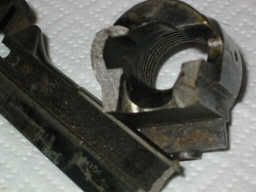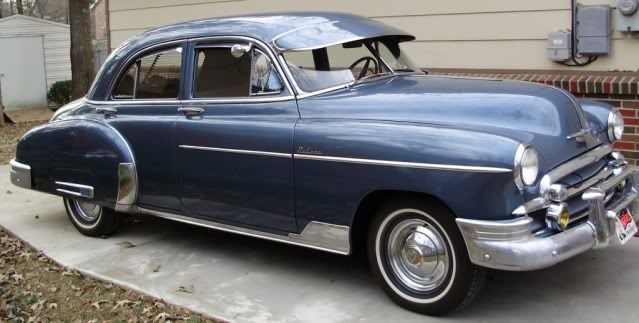

 The Accurate Reloading Forums
The Accurate Reloading Forums  THE ACCURATE RELOADING.COM FORUMS
THE ACCURATE RELOADING.COM FORUMS  Rifles
Rifles  Sporterized Military Rifles
Sporterized Military Rifles  1903 reciever failures
1903 reciever failuresGo  | New  | Find  | Notify  | Tools  | Reply  |  |
| One of Us |
I found this article when researching the 1903 Springfield.The topic is the High number/Low number and receiver failure issue. Thought it might interest some of you. http://m1903.com/03rcvrfail/ | ||
|
| one of us |
Great artical & a good read. Thanks for finding it.  Doug Humbarger NRA Life member Tonkin Gulf Yacht Club 72'73. Yankee Station Try to look unimportant. Your enemy might be low on ammo. | |||
|
| One of Us |
That is a very poor article. The author did no testing of his own, he just quoted and theorized. Take a look at the old article in the Rifle Magazine where a number were given a whack test and they all broke. | |||
|
| One of Us |
Do you have a link to the article? ......civilize 'em with a Krag | |||
|
| One of Us |
The article was an epidemiological assessment of the risk of receiver failure based on historical data. It appears to be well done and demonstrates the early Springfields weren't all bolt action hand grenades like some would have us believe. It doesn't advocate using low number receivers in fact it acknowledges that some were unsafe. It does show that the vast majority, of low number rifles gave safe service as was proven by their record. Would I use one to make a custom rifle? No. Does the author suggest that one be used? No. Jerry Liles | |||
|
| one of us |
Best thing is to read Hatcher, the definitive authority and come to your own conclusion. Grizz Indeed, no human being has yet lived under conditions which, considering the prevailing climates of the past, can be regarded as normal. John E Pfeiffer, The Emergence of Man Those who can't skin, can hold a leg. Abraham Lincoln Only one war at a time. Abe Again. | |||
|
| One of Us |
The article is a complete failure in light of the actual testing and photos in the Rifle Magazine article. | |||
|
| One of Us |
The "whack test" proved you could break the action with a hammer. It did not prove the actions were unsafe when used as designed. To do that would have required firing tests. It is also often possible to break a Mod 98 with a "whack" through the left rail cutout. As I posted earlier the original article in question was an epidemiological assessment of risk based on historic data. It is no less valid for the author not having conducted additional firing tests. Both articles confirm that there was a problem with early '03 Springfields. Neither article advocates using an early (low number) '03 Springfield. The first article puts the level of risk in perspective, and the second effectively illustrates the brittleness of many of the early actions. The two articles are complimentary not conflicting. Jerry Liles | |||
|
| One of Us |
The article is crapola. The actions were not broken with a hammer. They were whacked with a screw driver. Until you have read the other article you have ZERO basis for comparison. | |||
|
one of us |
I have an early sporter, 250K range. Too cool not to shoot. I reduce my loads 5-10%. NRA Life Member, Band of Bubbas Charter Member, PGCA, DRSS. Shoot & hunt with vintage classics. | |||
|
| One of Us |
This one WAS hit by a hammer....  | |||
|
| One of Us |
More damaged receivers  | |||
|
| One of Us |
I notice the receiver rings are all intact and, presumably, would have retained the bolt. Jerry Liles | |||
|
| One of Us |
Friend of mine shoots his low number Springfield frequently and others do as well. Many were issued to troops during WW1 and have read that very few had any problems;however, I would not shoot one. Why take the chance of failure and injury?? When firing the rifle there is a fairly strong release of energy only about 4" from your head/eye. Not for me. | |||
|
| One of Us |
I've never been able to find a lot about how the receivers actually failed and exactly why. A ruptured case and massive gas release may blow the ring off any rifle regardless of hardness. If both lugs are seated equally in the seats it would appear the failure mechanism would be to blow the barrel off- that should be only force to split the receiver and with square threads and brittle metal I'm not sure how that would happen. Of course the bolts were also hard - I've read that some of the blow ups were actually bolt failures but don't know if that is valid. I can visualize that a lug breaking off or the bolt head fracturing could could case an unsupported case head to realize a lot of gas. Remember that they also changed the bolt hardeneing process when they changed it for the receiver. A later WWII bolt is a cheap and reversiable modification when I shoot my low numbered guns. Sedgley built his sporters on low numbered guns and I have never heard of one of those blowing up. He is reported to have re-heat treated them but most state that is impossible without "burning' the metal. In any even he built a classic American sporter that has never been really appreciated.
| |||
|
| One of Us |
Please,Please,Please,Just keep all hammers and screwdrivers well away from these actions.It seems they do not get along. | |||
|
| One of Us |
it does hurt to see them broken like that, doesn't it? Especially the one that only bent the rail. That should have been a perfectly serviceable action. I do like the '03. Jery Liles | |||
|
| One of Us |
The article was in a Rifle magazine and the mallet was one of those little plastic faced things. The broken receivers were merely held in one hand and whacked. Notice how some of them merely fell into pieces. | |||
|
| One of Us |
I'm no Springfield expert and I didn't read any of these articles. BUT, it would be reasonably simple to take one of those fragments and figure out what is wrong with it. Any type of properly heat treated steel, regardless of shape and even hardness to some extent, would not shatter by impacting it with a plastic faced hammer. There are many forms of embrittlement. And almost as many ways to relieve it. If heat treat was the culprit, one would think a re-temper experiment might prove helpful. | |||
|
| One of Us |
Walnut, Sedgley did just that and made a lot of rifles on reheat treated '03s that seem to have done well. Springfield Armory studied the problem and came to the conclusion that it was not possible to reliably determine which actions would be treatable and which were too brittle or "burnt" to benefit. The commission that studied the problem recommended condemning all low number actions but the Army elected to continue using them or placing them in storage as second line. A lot of them were used during the early part of WW II. Gen Hatcher has a chapter in his Notebook on these actions. Jerry Liles | |||
|
| One of Us |
Interesting stuff. At least somebody gave it the old college try to salvage them. I have to make this type of decision occasionally myself and I lean towards repair. But, sometimes it simply is not worth the effort when re-manufacture is more sensible. "Use as is" is the last consideration and only when catastrophic failure or life threatening issues are NOT a possibility. Once a long time ago, I was faced with 90,000 parts, some of which had an internal crack due to heat treat. Try as I might, I could NOT fail them with any test I put them through. Some tests were above and beyond what the standards required. My vote went with scrap and remake. The president of the company backed me, and begrudgingly scrapped $30,000.00 worth of finished product. 30 grand worth of sales. I wasn't a popular guy that week. LOL. My reasoning was influenced. (It really shouldn't be) But I had heard that the bolts were used to hold wheels together on the Bradley Fighting Vehicle. | |||
|
| One of Us |
I suspect this is a case of camouflaged cover up by someone in the US Ordinance chain of command. They could have stripped and re-heat treated a couple hundred samples and then made a decision based on the results. As it was they basically did nothing. There are articles that discuss Sedgley's heat treating method and barreling practices. I am sure Sedgley blew up the rifles that were found not to pass their crude heating processes. | |||
|
| One of Us |
FWIW-The well known gunsmith Ralph Walker mentioned in his gunsmithing book having an authority position in an armory that rebarreled thousands of 03's before and during WW2. This included low number, double heat treated,and nickel steel actions of all the makes. He reported no low numbered recievers ever failed the rebarrel proof firing and in fact only one reciever ever did- a late Remington nickel steel 03A3. I no longer have the book but believe I remember his statement correctly. I also have read the Rifle article which also mentioned Enfield 17's breaking. So would I shoot a low no. Springfield? Well, sort of like swimming where Great Whites are seen from time to time. But if the boat is sinking...... | |||
|
| One of Us |
I respect Ralph Walker's statment, but there is another way to view it. If the low number rifles were on any restricted use status they would be much less likely to need rebarreling. I have seen some strange material failures after 40+ years in manufacturing. I would expect some failures if thousands of anything were proof tested. | |||
|
| one of us |
i've been reading this stuff about Springfields for years. I'm glad someone rememberd who mostly put it to rest(Ralph Walker). I remember an article I read years ago that stated none had ever failed in service with service loads. This stuff comes up every generation or so. Call it stuff you know for sure thst's not true. Anything Worth Doing Is Worth Overdoing. | |||
|
| One of Us |
Dr Duc You obviously do not believe the photos above. Why is that? | |||
|
| One of Us |
Be interesting to see 1903 reciever failures from firing? I see reciever failures from hitting them with a hammer..................................... I don't think installing them in a vise and beating them with a hammer was within their design parameters. | |||
|
| one of us |
Exactly. Where are the failures from firing standard loads? I know a guy who broke 12 of them back in the day when they were $20 for a whole Springfield. He used a ball pen hammer and they broke very easily. By the same token an old gunmaker friend (Henry Cheatham)had the low number gun he made in 1928 and still used it in 2004 until his death(from heart disease not metal fatigue). He was a very careful guy and very well educated in metallurgy. He never worried about it or so he told me. This is kind of like the Ross rifle bolt issue but with less real evidence of a problem in service. It's possible to blow them up but did any of them really fail in service? Probably not . Anything Worth Doing Is Worth Overdoing. | |||
|
| One of Us |
For a specific incident of one failing in normal service read Townsend Whelen's book "Mister Rifleman" (co-authored by Bradford Angier). One of the men under his command (a Private Manuel) in his company (he was then a company-grade officer, not yet a field-grade one) had one blow apart with Whelen present when firing on the rifle range in the Phillipines in 1907. The rifle's front receiver ring shattered and the rear receiver bridge and bolt stop also failed. The bolt landed some distance from the shooter, but luckily the shooter was not seriously harmed. As he was wearing glasses, he got a LOT of "pepper" marks on his face from the striking of burning powder grains on his skin, but his eyes were not injured. Whelen, who was also detailed on and off as an inspector of rifle training for the whole Army, estimates that over his career, he became aware of about 50 such Springfield low-number rifle failures in ordinary service. Incidentally, as to re-heat treating Springfield receivers, to do so to make them "safe" would require re-carburizing the receivers and then re-heat treating. The problem was apparently that with inadequate pyrometer control (none, actually) of the heat-treating originally done at the manufacturing armouries, the metal became "burnt" during its original receiver manufacture, not during some later process. (It never ceases to amaze me how all these modern "experts" feel they can re-write history with impunity, when the original reporters of such problems were actually there and stated what they saw/experienced...or in Whelan's case, both saw and was tasked to research.) Next thing you know, some future guy will claim that the 9/11 terrorism at the WTC was actually part of a commercial venture to get control of that high value real estate, financed and planned by the Russian Mafia in cahoots with the the Swedish & Japanese national police. My country gal's just a moonshiner's daughter, but I love her still. | |||
|
| One of Us |
Now Dr Duc I am sure you are full of it. Care to name the year they were sold for $12 each? | |||
|
| One of Us |
I notice lots of anecdotal posts where folks are saying things like "So & so had four of them and shot them for 53 years with no problems at all". Actually, that is part of the problem the Army had at the time in deciding what to do, if anything. As the armouries making the Springfield '03 did not initially have pyrometers, they never knew which actions had been heated to what temperatures for how long. The people heat-treating the actions were long-experienced employees who judged the heat by eye-balling the colour of the actions as they were heated. As the ambient light of the workplace varied by the hour/day/week/month/year, and the performance of individual eyes varied as they tired, were strained, whatever), the temps actually achieved and their durations also varied. Because the employees TRIED to be careful at their work and to make good equipment for the troops, most of the receivers were NOT heated to the point of burning the carbon content out of the steel, thus NOT making it brittle. Most of the receivers were perfectly okay. But short of destruction testing, which would have resulted in NO rifles produced if all the actions were so tested before being assembled into rifles, it wasn't really possible back then to tell exactly which "some" were NOT okay. So, I guess the question isn't whether one or a mllion were good, great, or unsafe rifles, but rather, "Do you feel like playing the safety lottery today?" My country gal's just a moonshiner's daughter, but I love her still. | |||
|
| One of Us |
I think it was mostly a problem of damage control and budget. The Army just coped (hid) with the problems the best it could. They could not scrap the receivers without a furor. I think they must have just put them on limited or restricted use and gave as many to the National Guard as they could. | |||
|
| one of us |
First of all, if you'd read carefully, he clearly doesn't say they were sold for $12 but rather $20 and I can remember them being common at gun shops in the 50s for $25 or so, so I'm sure they were sold for less than that from time to time. Here is an anecdotal line from another site verifying those price ranges (it had a pic but that won't transfer over):
[ xxxxxxxxxx When considering US based operations of guides/outfitters, check and see if they are NRA members. If not, why support someone who doesn't support us? Consider spending your money elsewhere. NEVER, EVER book a hunt with BLAIR WORLDWIDE HUNTING or JEFF BLAIR. I have come to understand that in hunting, the goal is not the goal but the process. | |||
|
| One of Us |
If you read carefully you will notice that the guy broke some of them too. Try reading about a charpy or izod impact test and how the results of it may translate into something more meaningful than "I knew a guy that bought them for $20 each". | |||
|
| one of us |
In 1968 you could get them from the Anniston Depot for $20.00 each. You could get a NEW carbine for the same price from the NRA. A friend(George Lautenschlager ) bought one. When he got the box it was larger than he thought. Inside wre 4 rifles. He called and was told it was more cost effective to ship 4 than to splt the box. In effect $5.00 Springfields. I bought my first one(in modern times) in 1985 sporterized for $50.00 and a new in the box example in 1990 for $120. My very first Springfield was a "behind the door" gun from Ed Cole for$9.00 in 1955. I pid for it wth paper route money. My brother bought a P13 for $10.00 from DB Holton a the same time. Henry and I talked about the receiver problem at length in the early 90s and he was not particularly concerned about it. He built it in 1927 and used it all his life The rifle was Rock Island in the bad # range. On his first outing with it (on a bet)he killed a pelican sitting on he water offshore of St.Augustine ,Fl at over 300 yds . He didn't have to repeat the shot to prove his point. Alberta, I've read most of Whelen's work but I guess I missed that one. I'm sure it's there. I've said enough about this now. Anything Worth Doing Is Worth Overdoing. | |||
|
| One of Us |
I bought my current Springfield (it was a new and unissued 2-groove A3-03) from DCM in 1964 for $14.50 including shipping, delivered to my home in Walton, Oregon. As to the Whelen report on the Springfield blowup which I mentioned in an earlier post, it is definitely in the book "Mr. Rifleman". I read it again not 10 minutes before posting that, to make sure I had the correct name of the trooper who was shooting it. That report ends with his (Whelen's) comment that he knew of approximately 50 such incidents. That's not a lot, considering there were something around a million of the low number rifles made, if you include both Springfield and Rock Island numbers. But lots of folks play the lottery every day , hoping to win against odds even poorer than that. And some DO win either the whole schlemozzle, or another very memorable prize. Me, I don't play the "shoot low number Springfields" lottery because I don't WANT to win that "dynamite" prize! There are too many other rifles without that history of blowups, including other higher number springfields, so I just use them. I may have mentioned that I used to also play that game, but with Ross rifles....until one day when I fired one I had been using for years as my "canoe" gun. When I looked down after a shot, for no reason at all that I can recall, the bolt had come open by about 3/4-to-1" inch. That was enough for me. I sold it to someone else willing to risk winning that lottery. To each his own....none of us lives forever anyway. It's just the chance of being disfigured and/or crippled that un-nerves me. Take care, AC | |||
|
| One of Us |
I consider Daffy's Docs analysis seriously flawed. The Daffy Doc’s statistics are based on Hatcher’s Notebook which is not an all inclusive list of all 03 failures. Hatcher’s list starts 1917 and ends 1929. There are known failures after. Likely there were failures before, but they just were not reported or in the documentation which Hatcher had access. I also disagree with Daffy Doc’s risk percentages. His percentages are based on the total number of rifles built, not the rifles in use. There were about one million of these rifles built, but post WW1, there were never one million at service at any time. By the time you get to 1922 Congress authorized only 136,000 Officer’s and enlisted in the Regular Army. I could guess how many rifles were in service with an Army that small, and it sure would not be one million. Lets say, as a ridiculous example, that their were four rifles in use and the remaining one million in storage. Let also say that one of the four blew up. Daffy Doc’s analysis would give you the risk as one in a million. But for those rifles in use, it would be 25%. Daffy Doc’s analysis also does not take into account the destruction of single heat treat receivers. As rifle came into depot, the Army scrapped these receivers. The population of these things liable to hurt someone just got smaller and smaller over time. Any risk calculation based on the total production is misleading because that is not the actual risk to the user. The user’s risk of harm is much higher. By what amount, I don’t know. I am certain there are no databases extent which would allow the calculation of risk based on active duty rifles, but the Army had seen enough accidents and decided to take a course of action which would remove single heat treat receivers from the inventory. Daffy Doc also says:
Daffy Doc could not find any failure reports and is making the conclusion that absence proves no receivers failures. I disagree with this. The absence of records indicate the absence of records. That does not mean that there were never were records or accidents; there could have been. There are buildings full of records that the US Army and Marine Corp have right now which Daffy Doc will never see. These records will be disposed of by the lowest cost method which will guarantee the least embarrassment later. Might as well ask Daffy Doc how long he maintains paper records of his patients. I will bet it won’t be decades. All organizations have to undergo reoccurring data dumps, or there will not be space for the workers. The lack of records might also be due to there was a shooting war going on. Even the military prioritizes efforts as the culture changes from peacetime bureaucracy to a life and death struggle. How high a priority would there be to create rifle failure reports in a war time expansion? I think the correct answer is zero. If a rifle broke, someone threw it in a scrap bin and got busy filling out paper work for the real important things. Like the Guadalcanal invasion.
For the decision makers alive at the time, the accident rate was high enough that they took action. However the memory of the accidents in service, when these rifles were in most use, occurred beyond living memory. This is a trick played by deniers, from economic collapses to low number Springfield issues. No one is around who remembers the consequences or the causes. As an example, I am going to claim that this 1952 Power Glide Chevrolet is the safest car ever built. You know, as well as I, that this car does not have safety belts so when your skull hits the hard metal dash it will be cracked like an egg, it has drum brakes all around, seats will probably rip out of the floor on impact crushing you even more and the owner says it wants to roll over on curves. The suspension is very primitive. The forward visibility is awful with that shade. There is a dash mounted prism which you look through to see if the light has changed color. You might think that would cause accidents. But in spite of the lack of safety features I can make the claim that this vehicle is the safest car every built because no one can find a record of anyone dying in the things.  | |||
|
| One of Us |
Regina man killed in crash near Maple Creek CBC News Posted: Aug 17, 2011 12:25 PM CST Last Updated: Aug 17, 2011 12:25 PM CST Back to accessibility links Supporting Story Content Story Sharing Tools Share with Add This Print this story E-mail this story End of Supporting Story Content Back to accessibility links Beginning of Story Content A man is dead after two-car crash near Maple Creek Tuesday afternoon. It happened at the intersection of Highway 21 and the Trans-Canada Highway at around 3:35 p.m. CST. According to the RCMP, a 1998 Chev Lumina driven by a 66-year-old man was heading north on Highway 21 when it collided with a westbound 1952 Chevy at the intersection with the Trans-Canada. The second car was driven by a 44-year-old man from Regina. Both were taken to hospital in Maple Creek. The older man was treated and released, but the 44-year-old had received serious head injuries and was airlifted to Royal University Hospital in Saskatoon, where he died. Police haven't released the names. The cause of the accident is under investigation. Alcohol was not a factor and road conditions at the time were good, police said. http://www.cbc.ca/news/canada/...reek-crash-1108.html | |||
|
| One of Us |
He was on the way to the hospital after receiving a near lethal head wound from an exploding low number Springfield. | |||
|
| One of Us |
Darn, there goes that analogy. Or I could claim that there have been no fatalities between 1952 and 2011, again “proving” that a 1952 Power Glide is the safest car in the world. Sorry to read about the guy dying from head injuries. Those old vehicles, they are death traps, let no one convince you otherwise. | |||
|
| Powered by Social Strata | Page 1 2 3 4 |
| Please Wait. Your request is being processed... |
|

Visit our on-line store for AR Memorabilia

